The 1982 CM road tests reviewed and compared
Page 20
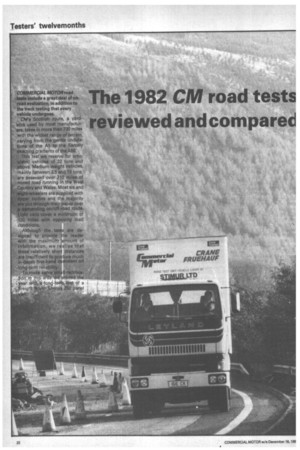
Page 21
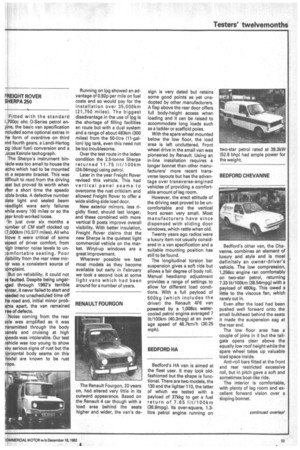
Page 22

Page 23
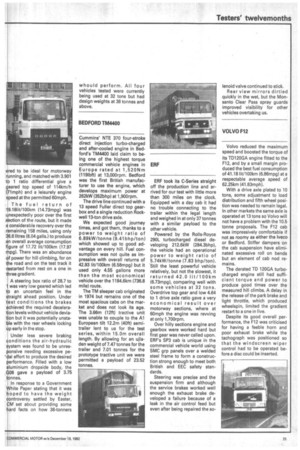
Page 24
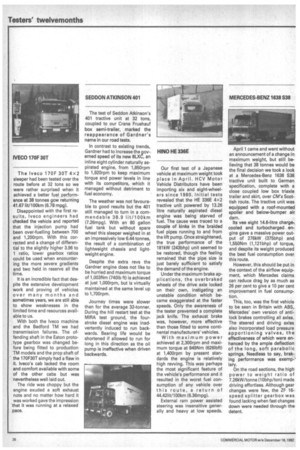
Page 25
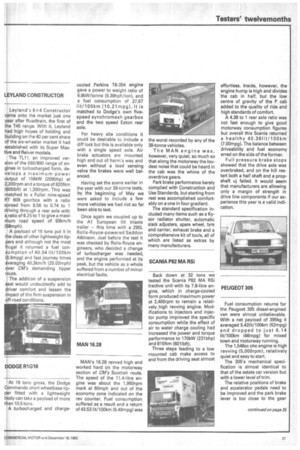
Page 27

Page 28
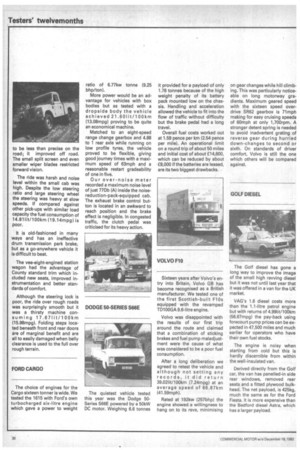
Page 29
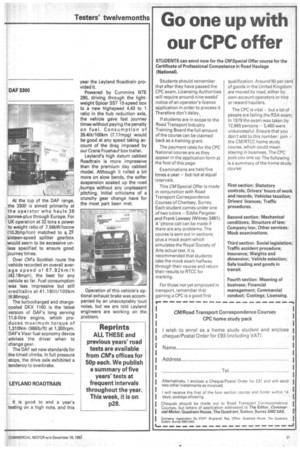
If you've noticed an error in this article please click here to report it so we can fix it.
Fitted with the standard 1,700cc ohc 0-Series petrol en)ine, the basic van specification ncluded some optional extras in he form of overdrive on third rid fourth gears, a Landi-Hartog pg (dual fuel) conversion and a _ucas Keinzle tachograph.
The Sherpa's instrument bin14cle was too small to house the aicho which had to be mounted )n a separate bracket. This was iifficult to read from the driving ;eat but proved its worth when ifter a short time the speedo :able broke. A defective number )late light and sealed beam leadlight were early failures while every 100 miles or so the )ear knob worked loose.
1ln just over six months a mber of CM staff clocked up I ,000km (10,577 miles). All who ove it were critical of some pect of driver comfort, from
ii h interior noise levels to unmfortable seating. Poor ibility from the rear view mirr was a consistent source of mplaint.
But on reliability, it could not faulted. Despite being ungar
ed through 1982's terrible vinter, it never failed to start and leeded no unscheduled time off hO road and, initial minor probeIns apart, the van remained r e of defects.
Noise coming from the rear 3 le was amplified as it was r nsmitted through the body ) nels and cruising at high tpeeds was intolerable. Our test vehicle was too young to show my serious signs of rust but the lorizontal body seams on this rodel are known to be rust Taps.
Running on lpg showed an advantage of 0.92p per mile on fuel costs and so would pay for the installation over 35,000km (21,750 miles). The biggest disadvantage in the use of lpg is the shortage of filling facilities en route but with a dual system and a range of about 483km (300 miles) from the 50-litre (11-gallon) lpg tank, even this need not be too troublesome.
Over the test route in the laden condition the 2.5-tonne Sherpa returned 1 1.7 5 lit/1 0 Okm (24.04mpg) using petrol.
Later in the year Freight Rover revised this vehicle. This had vertical panel seams to overcome the rust criticism and allowed Freight Rover to offer a wide sliding side load door.
New exterior mirrors, less rigidly fixed, should last longer, and these combined with more vertical B posts improve overall visibility. With better insulation, Freight Rover claims that the new Sherpa is the quietest light commercial vehicle on the market. Wind-up windows are a great improvement.
Wherever possible we test most models as they become available but early in February we took a second look at some light vans which had been around for a number of years.
The Renault Fourgon, 20 years on, had altered very little in its outward appearance. Based on the Renault 4 car though with a load area behind the seats higher and wider, the van's de sign is very dated but retains some good points as yet unadopted by other manufacturers. A flap above the rear door offers full body-height access when loading and it can be raised to accommodate long loads such as a ladder or scaffold poles.
With the spare wheel mounted below the low floor, the load area is left uncluttered. Front wheel drive in the small van was pioneered by Renault. Using an in-line installation requires a longer bonnet than other manufacturers' more recent transverse layouts but has the advantage over transverse-engined vehicles of providing a comfortable amount of leg room.
However, the erect attitude of the driving seat proved to be uncomfortable and the vertical front screen very small. Most manufacturers have since dispensed with sliding door windows, which rattle when old.
Twenty years ago radios were a luxury item not usually considered in a van specification and a suitable mounting position has still to be found.
The longitudinal torsion bar suspension gives a soft ride but allows a fair degree of body roll. Manual headlamp adjustment provides a range of settings to allow for different load conditions. With a full payload of 500kg (which includes the driver) the Renault 4F6 van powered by a 1,008cc watercooled petrol engine averaged 7 lit/100km (40.3mpg) at an average speed of 48.7km/h (30.25 mph).
Bedford's HA van is aimed at the fleet user. It may look oldfashioned but the shape is functional. There are two models, the 130 and the lighter 110, the latter of which we tested with a payload of 37kkg to get a fuel return of 7.65 lit/1 0 Okm (36.9mpg). Its over-square, 1.3litre petrol engine running on
Bedford's other van, the Cheyenne, combines an element of luxury and style and is most definitely an owner-driver's vehicle. The low compression, 1,256cc engine ran comfortably on two-star petrol, returning 7.33 lit/100km (38.54mpg) with a payload of 460kg. This owed a little to the viscous fan, which rarely cut in.
Even after the load had been pushed well forward onto the small bulkhead behind the seats it made the suspension sag at the rear end.
The low floor area has a couple of joins in it but the tailgate opens clear above the equally low roof height while the spare wheel takes up valuable load space inside.
Anti-roll bars fitted at the front and rear restricted excessive roll, but in pitch gave a soft and sometimes boat-like ride.
The interior is comfortable, with plenty of leg room and excellent forward vision over a sloping bonnet. The Ford Fiesta van's body shell is similar to the car but with steel side panels in place of glass. Our test vehicle, powered by the largest 1,117cc of the two available, delivering 35.4kW (47.5bhp) at 5,500rpm, ran on four-star petrol, giving a return of 7.11 lit/100km (39.74mpg) with a 350kg (7711b) payload inclusive of driver.
Ford is more candid than most in quoting a space volume of 35.3cuft using the Din standard.
There are three accepted ways of measuring load volume with substantial differences between them. An evenly distributed load tends to overload the rear axle first and with front wheel drive there is a tendency to spin up the front wheels when starting from rest, especially on wet gradients.
In contrast, the conventional front engine, rear drive axle of the Datsun Sunny produceda light unladen rear end, which meant that traction improved as the load was added, and it could restart on a one in four gradient.
With a payload of 44 Okg (9701b) the 1,200cc petrol engine gave a rather sedate though smooth performance with an overall average consumption of 7.33 lit/100km (38.55mpg). The general level of trim was to the high standard we have come to expect from Japan but its vinyl seats are cold in winter, and hot and sticky in summer.
The demand for 4x4 vehicles has shown a steady increase over recent years, with a growing acceptance of some of the more luxuriously equipped. We looked at three of the most recent and popular models.
The Range Rover is equally at home in London traffic or in mud on a construction site. At the top of the range our test vehicle was equipped with four doors and air conditioning. The back seat folds down to expose a load volume of 2cum (70.8cuft).
The driving position is high and has good visibility, through a slightly curved screen. Instrumentation is contained within a binnacle, housed on the facia as if it had been put there only after the vehicle had been built.
Its de-tuned 3.5-litre petrol engine carried the extra burden of power steering and air-conditioning and power seemed a little lacking. Disc brakes front and rear behaved well under all conditions but the transmission's park brake required a good deal of effort for it to work effectively. Off road, the Range Rover seemed to be unstoppable. High mounted electrics kept working through deep fording even with the bonnet awash in heavy mud. Low ratio and the diff locks were used in earnest on only a couple of occasions.
Without doubt, the Range Rover's custom four-wheel drive offers more off-road capability than any sensible driver will need and it behaved equally well in heavy traffic or motorway, cruising conditions returning an average 17mpg. Now ten years old, the design remains contemporary.
Costing considerably less, the Toyota Land Cruiser gives the choice of two or four-wheeldrive, but the front wheels have to be locked in manually. Large 16in wheels give a good ground clearance of about 200mm (7.91n) and like the other two vehicles tested at this time it seemed to be all but unstoppable. It handled best in fourwheel-drive but low ratio is needed only when the going gets really tough.
Long semi-elliptical springs gave a good ride with some roll but the power steering contributed only minimal self-centring action.
Power was in the form of a low revving 3,980cc diesel engine, rated at 70kW (103bhp), and electrics are 24 volt. An effective preheat system helped with cold starts although this did produce some smoke until the engine became warm. The large 19.8-gallon fuel tank gives a good range at about 24mpg.
The Mercedes-Benz G Wa. gon was the most mechanically sophisticated of the 4x4 passenger vehicles we tested. The specification incorporated high and low ratios, both of which can be selected while on th,le move, as can the two/fourwheel-drive and independent diff locks, front and rear.
Our test vehicle was alsc equipped with a 2,746cc six-cylinder petrol injection power unit rated at 115kW (156bhp) at 5,25C rpm which produced quite exhilarating performance with revs maintained between 3,500 anc 5,500 through the gears on anc off the road.
The body styling, typically Ger manic, will take some time tc become accepted over here, ant the perfectly sensible use o' black rubber floor covering anc black plastic trim is too austere for a vehicle of this type. The firm Mercedes seats providec ample support but not much comfort.
With the Commando 2 001 7.5-tonne, Dodge dropped th( four-cylinder Perkins engine ir favour of the 6.354.4 direct injec tion and naturally aspirated six in-line unit. Its power and torqu( ratings of 73kW (98bhp) an 308Nm 12271bft) were consid ered to be ideal for motorway running, and matched with 3.901 to 1 ratio differential give a geared top speed of 114km/h (71mph) and a leisurely engine peed at the permitted 60mph.
The fuel return of 9.181it/100km (14.73mpg) was unexpectedly poor over the first section of the route, but it made a considerable recovery over the remaining 158 miles, using only 36.6 litres (8.04 galls.) to produce an overall average consumption f'gure of 17.72 lit/100km (17.97 pg). There was an abundance f power for hill climbing, for on
e road and on the test track it
started from rest on a one in
ree gradient.
A steering box ratio of 28.7 to was very low geared which led • an uncertain feel in the traight ahead position. Under est conditions the brakes chieved the required deceleraon levels without vehicle deviaon but it was potentially unstale with the rear wheels locking p early in the stop.
Under less severe braking onditions the air-hydraulic ystem was found to be unresonsive needing excessive peal effort to produce the desired erformance. Filled with a low aluminium dropside body, the 008 gave a payload of 3.75 tonnes.
In response to a Government White Paper stating that it was hoped to have the weight controversy settled by Easter, CM set about providing some hard facts on how 38-tonners
whould perform. All four vehicles tested were currently being used at 32 tons but had design weights at 38 tonnes and above.
Cummins' NTE 370 four-stroke direct injection turbo-charged and after-cooled engine in Bedford's TM4400 laid claim to being one of the highest torque commercial vehicle engines in Europe rated at 1,52 ONm (119Ibft) at 13,000rpm. Bedford was the first British manufacturer to use the engine, which develops maximum power at 262kW (352bhp) at 1,900rpm.
The drive line continued with a 13 speed Fuller direct top gearbox and a single reduction Rockwell 13-ton drive axle.
We expected good journey times, and got them, thanks to a power to weight ratio of 6.89kW/tonne (9.41bhp/ton) which showed up to good advantage on every hill. Fuel consumption was not quite as impressive with overall returns of 42.93 lit/100km (6.58mpg) but it used only 4.55 gallons more than the most economical vehicle over the 1184.6km (736.8 mile) route.
The TM sleeper cab originated in 1974 but remains one of the most spacious cabs on the market and does not look its age. The 3.66m (12ft) tractive unit was unable to couple to the Al European tilt 12.2m (40ft) semitrailer lent to us for the test series, within 15.0m overall length. By allowing for an ujladen weight of 7.47 tonnes for the trailer and 7.01 tonnes for the prototype tractive unit we were permitted a payload of 23.52 tonnes.
ERF took its C-Series straight off the production line and arrived for our test with little more than 300 miles on the clock. Equipped with a day cab it had no trouble connecting to the trailer within the legal length and weighed in at only 37 tonnes with a similar payload to the other vehicle.
Powered by the Rolls-Royce 290L turbocharged diesel developing 212.6kW (284.3bhp), the vehicle had an operational power to weight ratio of 5.74kW/tonne (7.83 bhp/ton). Still the least powerful vehicle relatively, but not the slowest, it returned 42.0 lit/1 0 0 km (6.73mpg), comparing well with some vehicles at 32 tons. Overdrive top gear and low 4.64 to 1 drive axle ratio gave a very economical result over motorway sections, where at 60mph the engine was revving at only 1,700rpm.
Over hilly sections engine and gearbox were worked hard but first gear was never called upon. ERF's SP3 cab is unique in the commercial vehicle world using SIV1C grp panels over a welded steel frame to form a construction strong enough to meet both British and EEC safety standards.
Steering was precise and the suspension firm and although the service brakes worked well enough the exhaust brake developed a failure because of a leak in the air control feed but even after being repaired the so
lenoid valve continued to stick.
Rear view mirrors dirtied quickly in the wet, but the Monsanto Clear Pass spray guards improved visibility for other vehicles overtaking us.
Volvo reduced the maximum speed and boosted the torque of its TD120GA engine fitted to the F12, and by a small margin produced the best fuel consumption of 41.18 lit/100km (6.86mpg) at a respectable average speed of 62.25km (41.83mph).
With a drive axle plated to 10 tons, some adjustment to load distribution and fifth wheel position was needed to remain legal. In other markets the same axle is operated at 13 tons so Volvo will not have a problem with the 10.5 tonne proposals. The F12 cab was impressively comfortable if not as roomy as either the lveco or Bedford. Stiffer dampers on the cab suspension have eliminated excessive roll on bends but an element of cab nod remains.
The derated TD 120GA turbocharged engine still had sufficient torque and power to produce good times over the measured hill climbs. A delay in the release of the park brake and light throttle, which produced wheelspin, limited the gradient restart to a one in five.
Despite its good overall performance, the F12 was criticised for having a feeble horn and poor exhaust brake while the tachograph was positioned so that the windscreen wiper control had to be operated before a disc could be inserted. The Iveco 1 7 OF 30T 4 x 2 sleeper had been tested over the route before at 32 tons so we were rather surprised when it achieved a better fuel performance at 38 tonnes gcw returning 41.67 lit/100km (6.78 mpg).
Disappointed with the first results, Iveco engineers had checked the vehicle and reported that the injection pump had been over-fuelling between 700 and 1,200rpm. With this corrected and a change of differential to the slightly higher 3.96 to 1 ratio, lower gearbox ratios could be used when encountering the more severe gradients and two held in reserve all the time.
It is an incredible fact that despite the extensive development work and proving of vehicles over many months and sometimes years, we are still Eible to show weaknesses in the limited time and resources available to us.
With both the Iveco machine and the Bedford TM we had transmission failures. The offending shaft in the Eaton prototype gearbox was changed before being fitted to production TM models and the prop shaft of the 170F30T simply had a flaw in it. Iveco's cab lacked the room and comfort available with some of the other cabs but was nevertheless well laid out.
The ride was choppy but the engine exuded a soft exhaust note and no matter how hard it was worked gave the impression that it was running at a relaxed pace. The test of Seddon Atkinson's 401 tractive unit at 32 tons, coupled to our Crane Fruehauf box semi-trailer, marked the reappearance of Gardner's name in our road tests.
In contrast to existing trends, Gardner had to increase the governed speed of its new 8LXC, an inline eight cylinder naturally aspirated engine, from 1,850rpm to 1,920rpm to keep maximum torque and power levels in line with its competitors, which it managed without detriment to fuel economy.
The weather was not favourable to good results but the 401 still managed to turn in a commendable 38.9 lit/100km (7.26mpg). With an 80 gallon fuel tank but without spare wheel this sleeper weighed in at an impressively low 6.44 tonnes, the result of a combination of lightweight chassis and lightweight engine.
Despite the extra revs the Gardner engine does not like to be hurried and maximum torque of 1,003Nm (740Ib ft) is achieved at just 1,000rpm, but is virtually maintained at the same level up to 1,700rpm.
Journey times were slower than for the average 32-tonner. During the hill restart test at the MIRA test ground, the fourstroke diesel engine was inadvertently induced to run backwards.' Bearing life would be shortened if allowed to run for long in this direction as the oil pump is ineffective when driven backwards.
Our first test of a Japanese vehicle at maximum weight took place in April. HCV Motor Vehicle Distributors have been importing six and eight-wheelers since 1980. Initial tests revealed that the HE 336E 4x2 tractive unit powered by 13.26 litre naturally aspirated diesel engine was being starved of fuel. The cause was traced to a couple of kinks in the braided fuel pipes running to and from the lift pump. Once straightened, the true performance of the 181kW (243bhp) unit seemed to be restored, though the feeling remained that the pipe size is just barely sufficient to satisfy the demand of the engine.
Under the maximum brake applications, the overbraked wheels of the drive axle locked on their own, instigating an unstable condition which became exaggerated at the faster speeds. Only the awareness of the tester prevented a complete jack knife. The exhaust brake was, however, more effective than those fitted to some continental manufacturers' vehicles.
With maximum power achieved at 2,300rpm and maximum torque at 849Nm (626Ibft) at 1A00rpm by present standards the engine is relatively high revving. This was perhaps the most significant feature of the vehicle's performance and it resulted in the worst fuel consumption of any vehicle over this route, a return of 44.421it/100km (6.36mpg).
External ram power assisted steering was insensitive generally and heavy at low speeds. April 1 came and went without an announcement of a change in maximum weight, but still believing that 38 tonnes would be the final decision we took a look at a Mercedes-Benz 1638 538 tractive unit built to German specification, complete with a close coupled low box triaxle trailer and skirt, over CM'S Scottish route. The tractive unit was equipped with a roof-mounted spoiler and below-bumper air dam.
Its vee eight 14.6-litre chargia,, cooled and turbocharged engine gave a massive power output of 276kW (376bhp) and 1,560Nm (1,121bhp) of torque, and despite its weight produced the best fuel consumption over this route.
However, this should be put in the context of the airflow equipment, which Mercedes claims can reduce drag by as much as 26 per cent to give a 10 per cent improvement in fuel consumption.
This, too, was the first vehicle to be seen in Britain with ABS, Mercedes' own version of antilock brakes controlling all axles. The steered and driving axles also incorporated load pressure apportioning valves, the effectiveness of which were enhanced by the ample deflection of the long, soft parabolic springs. Needless to say, braking performance was exemplary.
On the road sections, the high power to weight ratio of 7.26kW/tonne (10bhp/ton) made driving effortless. Although gear changes were few, the ZF 16speed splitter gearbox was found lacking when fast changes down were needed through the detent.
Leyland's 6 x 4 Constructor came onto the market just one Year after Roadtrain, the first of f
t e T45 range. With it, Leyland ad high hopes of holding and uilding on the 40 per cent share the six-wheeler market it had established with its Super MastiVe and Reiver models.
The TL11, an improved vers on of the 680/690 range of en
ines in turbocharged form, de
elops a maximum power Output of 156kW (20913hp) at 2k200rpm and a torque of 820Nm ( 05Ibft) at 1,300rpm. This was
atched to a Fuller nine-speed
609 gearbox with a ratio spread from 8.56 to 0.74 to 1 driving through a rear axle with a ratio of 6.25 to1 to give a maximum road speed of 93km/h (58mph).
A payload of 16 tons put it in the class of other lightweight tippers and although not the most frugal it returned a fuel con
umption of 40.94 lit/100km ( .9mpg) and fast journey times veraging 40.3km/h (25.02mph) ver GM's demanding tipper rbute.
The addition of a suspension eat would undoubtedly add to river comfort and lessen the i pact of the firm suspension in if-road conditions.
At 16 tons gross, the Dodge Commando short wheelbase tipper fitted with a lightweight body can take a payload of more than 10.5 tons.
A turbocharged and charge cooled Perkins T6-354 engine gave a power to weight ratio of 6.8kW/tonne (9.39hph/ton), and a fuel consumption of 27.67 lit/100km (10.21 mpg). It is matched to Dodge's own fivespeed synchromesh gearbox and the two speed Eaton rear axle.
For heavy site conditions it could be desirable to include a diff lock but this is available only with a single speed axle. Air brake actuators are mounted high and out of harm's way and even without a load sensing valve the brakes were well balanced.
Having set the scene earlier in the year with our 38-tonne tests, by the beginning of May we were asked to include a few more vehicles we had not so far been able to test.
Once again we coupled up to the Al European tilt triaxle trailer — this time with a 290L Rolls-Royce-powered Seddon Atkinson. Just before the test it was checked by Rolls-Royce engineers, who decided a change of turbocharger was needed, and the engine performed at its peak, but the vehicle as a whole suffered from a number of minor electrical faults.
MAN's 16.28 revved high and worked hard on the motorway section of CM's Scottish route. The speed of the 11.4-litre engine was about the 1,950rpm mark at 60mph and out of the economy zone indicated on the rev counter. Fuel consumption suffered as a result and a ret0rn of 43.531it/100km (6.49mpg) was
the worst recorded by any of the 38-tonne vehicles.
The MAN engine was, however, very quiet; so much so that along the motorway the loudest noise that could be heard in the cab was the whine of the overdrive gears.
Park brake performance barely complied with Construction and Use Standards, but starting from rest was accomplished comfortably on a one in four gradient.
The standard specification included many items such as a Kysor radiator shutter, automatic slack adjusters, spare wheel, tyre and carrier, exhaust brake and a comprehensive kit of tools, all of which are listed as extras by many manufacturers.
Back down at 32 tons we tested the Scania P82 MA RSi tractive unit with its 7.8-litre engine, which in charge-cooled form produced maximum power at 2,400rpm to remain a relatively high revving engine. Modifications to injectors and injector pump improved the specific consumption while the effect of air to water charge cooling had increased the power and torque performance to 170kW (231bhp) and 815Nm (601Ibft).
Three steps leading to a low mounted cab make access to and from the driving seat almost
effortless. Inside, however, the engine hump is high and divides the cab in half, but the low centre of gravity of the P cab added to the quality of ride and high standards of comfort.
A 4.38 to 1 rear axle ratio was not fast enough to give good motorway consumption figures but overall this Scania returned a healthy 4 0.3 6lit/1 0 Okm (7.00mpg). The balance between driveability and fuel economy erred on the side of the former.
Full pressure brake stops showed that the drive axle was overbraked, and on the hill restart both a half shaft and a propshaft uj failed. It would seem that manufacturers are allowing only a margin of strength in drive line components if our experience this year is a valid indication.
Fuel consumption returns for the Peugoet 305 diesel-engined van were almost unbelievable. With a net payload of 395kg it averaged 5.421it/100km (52mpg) and dropped to just 6.14 lit/100km (46mpg) for mixed town and motorway running.
The 1,548cc ohc engine is high revving (5,000rpm), relatively quiet and easy to start.
The 305's mechanical specification is almost identical to that of the estate car version but with a lower level of trim.
The relative positions of brake and accelerator pedals need to be improved and the park brake lever is too close to the gear stick. In other ways, the standard of driver comfort is good if not luxurious. The van has a lively performance, handles well and provides a. sensibly dimensioned load space of 1.58 cum (56.5cuft) measured by the DIN method. Front-wheel-drive allows a platform height of 0A9m (1ft 71n) in the unladen condition.
The introduction of the P100 pick-up from Ford came just before the Cortina on which it is Lased was replaced by the ierra. It has been available in outh Africa for some time and i imported from that country. Powered by Ford's 1.6-litre he petrol engine it gave a fuel Ie,
nsumption of 11.71it/100km ( 4.15mpg) round CM's light van ute with a payload just short of he maximum 1,075 kg ( 1.17cwt). The engine proved to down on power at this weight nd worked hard to achieve a low average speed for the ute. The 185x14 eight ply res, which are larger than pecified for the car, made the eteering heavy at slow speeds. i The P100 benefits from its Cortina origins for even the tallest
tivers can sit comfortably. A ck rear pillar produces a blind Spot and the umbrella-type park
rake is just out of reach if one is at back in the driving seat.
A 2.13m (7ft) platform comes lose to being the longest avail ble but the double skin of the load box restricts the useable width though it may help in avoiding damage to the outer panels from the load. In July we took a look at two versions of the Fiat Daily, with different engines. The 35.9 has a two-litre petrol engine while the 35.8 is driven by a 2.5-litre diesel unit. The petrol unit rated at 60kW (8.5bhp) and with a torque of 152Nm (112Ib/ft) is the slightly more powerful model.
The petrol van was lighter by 175kg (3.5cwt) with a kerb weight of 1,785kg (1ton 15cwt). Outwardly, the two 3.5-tonne panel vans looked much the same and each has a load capacity of 9.8cum (346cuft). Beneath the skin there were small differences in clutch size and suspension.
The diesel-engined model was the more frugal of the two vehicles returning 10.88 lit/100km (25.96mpg) while the petrol van averaged 13.41it/100km (21.08mpg). Both engines felt underpower when the vans were fully laden.
These large vans have a distinctive body style which is modern and roomy. They were quiet, comfortable and pleasant to drive. Lack of power was a criticism levelled at Bedford's TL 7.5 tonner. Its 3.6-litre turbocharged engine was rated at 53.9kW (72 bhp) and was specified with an overall gearing suited best to town delivery work.
Over CM's Welsh route it was little surprise that it produced slow journey times and mediocre fuel consumption figures.
If it highlighted anything, it is the importance of specifying a vehicle correctly for the job in hand. However Bedford introduced a more powerful version of the engine at the NEC show in October.
The TL cab is less than the full vehicle width but gives a wider interior than on the older TK models, while the shelf behind the seats gives a feeling of spaciousness.
Klockner Humboldt Deutz is no longer part of lveco but continues to supply the yee-eight engine which is fitted to this Magirus. With its maximum torque of 1,110Nm :819Ibft) developed at 1,500rpm, engine revs had to be kept relatively high but this did not adversely affect fuel consumption, which was 40.471it/100km (6.98mP9).
The Fuller 13-speed overdrive Road Ranger gearbox matched to a 4.87 to 1 rear axle ratio allowed easy motorway running and good restart gradeability. Since Paccar's take-over of Foden, the newly formed Sandbach Engineering Company builds only to order and offers an unusually wide choice of specification on major components. When we tested the S108 8x4 it had already been in service with K&M Hauliers of Nottingham who had specified the Gardner 6L X CT turbocharged engine rated at 171kW (240bhp) matched to a Fuller RTX 11609B range-change gearbox driving through a Rockwell single reduction rear axle.
The new Gardener's overall average fuel consumption of 44.71it/100km (5.92mpg) over CM's route provides more evidence of how economical an engine it is.
The Foden FF20 dual rate rubber suspension fitted as standard to the rear bogie contributed to a smooth ride over rough going and resisted excessive roll.
A high load specification has increased the payload of the long wheelbased Land Rover to 1.3 tonnes. Listed engine options include a vee-eight 3.5-litre petrol unit and 2.25 petrol and diesel units. We tested it with the middle power option of the four cylinder petrol unit developing 52kW (70bhp) and found the steeringto be less than precise on the road. It improved off road but the small split screen and even smaller wiper blades restricted forward vision. to be less than precise on the road; it improved off road. The small split screen and even smaller wiper blades restricted forward vision.
The ride was harsh and noise level within the small cab was high. Despite the low steering ratio and large steering wheel the steering was heavy at slow speeds. If compared against other pick-ups with similar load capacity the fuel consumption of 14.8111t/100km (19.14mpg) is poor.
It is old-fashioned in many ways and has an ineffective drum transmission park brake, but as a go-anywhere vehicle it is difficult to beat.
The vee-eight-engined station wagon had the advantage of County standard trim which included new seats, improved instrumentation and better standards of comfort.
Although the steering lock is poor, the ride over rough roads was surprisingly smooth but it was a thirsty machine consuming 17.67 lit/ 100 km (15.98mpg). Folding steps located beneath front and rear doors are of marginal benefit and are all to easily damaged when belly clearance is used to the full over rough terrain.
The choice of engines for the Cargo sixteen tonner is wide. We tested the 1615 with Ford's own turbocharged six-litre engine which gave a power to weight ratio of 6.77kw tonne (9.25 bhp/ton).
More power would be an advantage for vehicles with box bodies but as tested with a dropside body the vehicle achieved 21.601it/100 km (13.08mpg) proving to be quite an economical machine.
Matched to an eight-speed range change gearbox and 4.88 to 1 rear axle while running on low profile tyres, the vehicle proved to be flexible, giving good journey times with a maximum speed of 63mph and a reasonable restart gradeability of one in five.
Our over-noise meter recorded a maximum noise level of just 77Db (A) inside the noisereduction-pack-equipped cab. The exhaust brake control button is located in an awkward to reach position and the brake effect is negligible. In congested traffic, the clutch pedal was criticised for its heavy action.
The quietest vehicle tested this year was the Dodge 50Series S66E powered by a 50kW DC motor. Weighing 6.6 tonnes it provided for a payload of only 1.78 tonnes because of the high weight penalty of its battery pack mounted low on the chassis. Handling and acceleration allowed the vehicle to fit into the flow of traffic without difficulty but the brake pedal had a long travel.
Overall fuel costs worked out at 1.59 pence per km (2.54 pence per mile). An operational limit on a round trip of about 50 miles and initial cost of about £14,600, which can be reduced by about .£8,000 if the batteries are leased, are its two biggest drawbacks.
Sixteen years after Volvo's entry into Britain, Volvo GB has become recognised as a British manufacturer. We tested one of the first Scottish-built F1Os equipped with the revamped TD100GA 9.6-litre engine.
Volvo was disappointed with the results of our first trip around the route and claimed that a combination of sticking brakes and fuel pump maladjustment were the cause of what was considered to be a poor fuel consumption.
After a long deliberation we agreed to retest the vehicle and although not setting any records, it did return 39.021it/100km (7.24mpg) at an average speed of 66.87km (41.59mph).
Rated at 192kw (257bhp) the engine showed a willingness to hang on to its revs, minimising on gear changes while hill climbing. This was particularly noticeable on long motorway gradients. Maximum geared speed with the sixteen speed overdrive SR62 gearbox is 71mph making for easy cruising speeds of 60mph at only 1,700rpm. A stronger detent spring is needed to avoid inadvertent grating of reverse gear during hurried down-changes to second or sixth. On standards of driver comfort, Volvo is still the one which others will be compared against.
The Golf diesel has gone a long way to improve the image of the small high revving diesel but it was not until last year that it was offered in a van for the UK market.
VAG's 1.6 diesel costs more than the 1.1-litre petrol engine but with returns of 4.991it/100km (56.67mpg) the pay-back using forecourt pump prices can be expected in 47,500 miles and much earlier for operators who have their own fuel stocks.
The engine is noisy when starting from cold but this is hardly discernible from within the well-insulated van.
Derived directly from the Golf car, the van has panelled-in side rear windows, removed rear seats and a fitted plywood bulkhead. The net payload, is 425kg, much the same as for the Ford Fiesta. It is more expensive than the Bedford diesel Astra, which has a larger payload. At the top of the DAF range the 3300 is aimed primarily at the operator who hauls 38 tonnes-plus through Europe. For UK operation at 32 tons a power to weight ratio of 7.56kW/tonne (10.3bhp/ton) matched to a ZF sixteen-speed splitter gearbox would seem to be excessive unless specified to ensure good journey times.
Over CM's Scottish route the vehicle recorded an overall average speed of 6 7.8 2km/h (42.18mph), the best for any vehicle so far. Fuel consumption was less impressive but still creditable at 41.181it/100km (6.86mpg), The turbocharged and chargecooled DKX 1160 is the latest version of DAF's long serving 11.6-litre engine, which produces maximum torque of 1,310Nm (9661b/ft) at 1,300rpm. DAF's Visar fuel economy device advises the driver when to change gear.
The DAF set new standards for the timed climbs. In full pressure stops, the drive axle exhibited a tendency to overbrake. year the Leyland Roadtrain provided it.
Powered by Cummins NTE 290, driving through the lightweight Spicer SST 10-speed box to a new highspeed 4.43 to 1 ratio in the hub reduction axle, the vehicle gave fast journey times without paying the penalty on fuel. Consumption of 39.411t/100km (7.17mpg) would be good at any speed taking account of the drag imposed by our Crane Fruehauf box trailer.
Leyland's high datum cabbed Roadtrain is more impressive than the premium day cabbed model. Although it rolled a bit more on slow bends, the softer suspension soaked up the road )bumps without any unpleasant pitching. Initial criticisms of a crunchy gear change have for the most part been met.
Operation of this vehicle's optional exhaust brake was accompanied by an unacceptably loud noise, but we are told Leyland engineers are working on the problem.




































